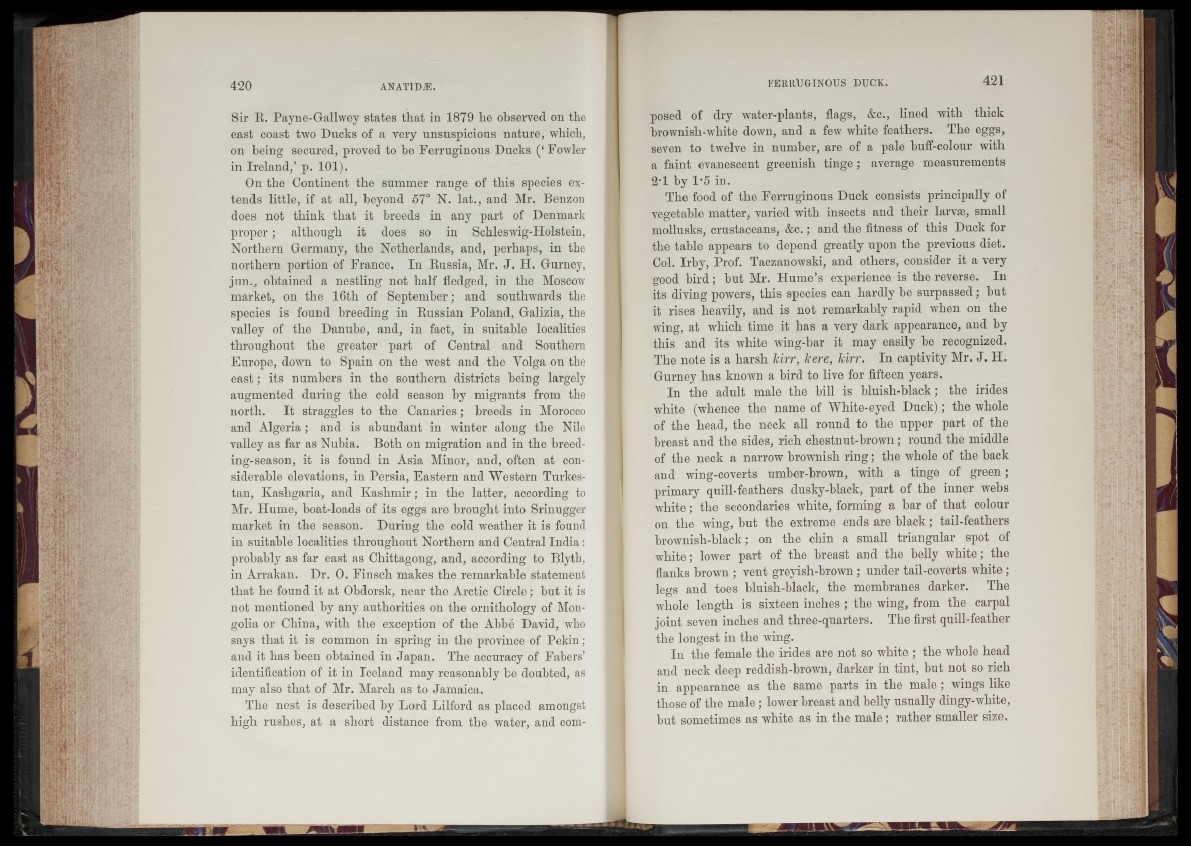
Sir R. Payne-Gallwey states that in 1879 he observed on the
east coast two Ducks of a very unsuspicious nature, which,
on being secured, proved to be Ferruginous Ducks (‘ Fowler
in Ireland,’ p. 101).
On the Continent the summer range of this species extends
little, if at all, beyond 57° N. lat., and Mr. Benzon
does not think that it breeds in any part of Denmark
proper ; although it does so in Schleswig-Holstein,
Northern Germany, the Netherlands, and, perhaps, in the
northern portion of France. In Russia, Mr. J. H. Gurney,
jun., obtained a nestling not half fledged, in the Moscow
market, on the 16th of September ; and southwards the
species is found breeding in Russian Poland, Galizia, the
valley of the Danube, and, in fact, in suitable localities
throughout the greater part of Central and Southern
Europe, down to Spain on the west and the Volga on the
east; its numbers in the southern districts being largely
augmented during the cold season by migrants from the
north. It straggles to the Canaries ; breeds in Morocco
and Algeria ; and is abundant in winter along the Nile
valley as far as Nubia. Both on migration and in the breeding
season, it is found in Asia Minor, and, often at considerable
elevations, in Persia, Eastern and Western Turkestan,
Kashgaria, and Kashmir ; in the latter, according to
Mr. Hume, boat-loads of its eggs are brought into Srinugger
market in the season. During the cold weather it is found
in suitable localities throughout Northern and Central India :
probably as far east as Chittagong, and, according to Blyth,
in Arrakan. Dr. 0. Finscli makes the remarkable statement
that he found it at Obdorsk, near the Arctic Circle ; but it is
not mentioned by any authorities on the ornithology of Mongolia
or China, with the exception of the Abbé David, who
says that it is common in spring in the province of Pekin ;
and it has been obtained in Japan. The accuracy of Fabers’
identification of it in Iceland may reasonably be doubted, as
may also that of Mr. March as to Jamaica.
The nest is described by Lord Lilford as placed amongst
high rushes, at a short distance from the water, and composed
of dry water-plants, flags, &c., lined with thick
brownish-white down, and a few white feathers. The eggs,
seven to twelve in number, are of a pale buff-colour with
a faint evanescent greenish tinge ; average measurements
2*1 by 1*5 in.
The food of the Ferruginous Duck consists principally of
vegetable matter, varied with insects and their larvse, small
mollusks, crustaceans, &c.; and the fitness of this Duck for
the table appears to depend greatly upon the previous diet.
Col. Irby, Prof. Taczanowski, and others, consider it a very
good bird ; but Mr. Hume’s experience is the reverse. In
its diving powers, this species can hardly be surpassed; but
it rises heavily, and is not remarkably rapid when on the
wing, at which time it has a very dark appearance, and by
this and its white wing-bar it may easily be recognized.
The note is a harsh kirr, here, kirr. In captivity Mr. J. H.
Gurney has known a bird to live for fifteen years.
In the adult male the bill is bluish-black ; the irides
white (whence the name of White-eyed Duck); the whole
of the head, the neck all round to the upper part of the
breast and the sides, rich chestnut-brown ; round the middle
of the neck a narrow brownish ring; the whole of the back
and wing-coverts umber-brown, with a tinge of green;
primary quill-feathers dusky-black, part of the inner webs
white; the secondaries white, forming a bar of that colour
on the wing, but the extreme ends are black ; tail-feathers
brownish-black; on the chin a small triangular spot of
white; lower part of the breast and the belly white; the
flanks brown ; vent greyish-brown ; under tail-coverts white ;
legs and toes bluish-black, the membranes darker. The
whole length is sixteen inches ; the wing, from the carpal
joint seven inches and three-quarters. The first quill-feather
the longest in the wing.
In the female the irides are not so white ; the whole head
and neck deep reddish-brown, darker in tint, but not so rich
in appearance as the same parts in the male ; wings like
those of the male ; lower breast and belly usually dingy-white,
but sometimes as white as in the male; rather smaller size.